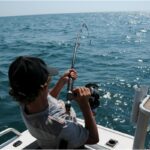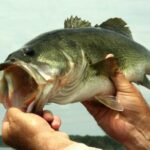The redeye bass goes by several names, including redeye, Coosa bass, and its scientific name, Micropterus coosae. This freshwater fish is a popular game fish for anglers who enjoy a good challenge.

Photo Source: Drewrmorgan, CC BY-SA 3.0 https://creativecommons.org/licenses/by-sa/3.0, via Wikimedia Commons
The redeye may not be the biggest fish in the world, but it puts up a good fight. It takes a lot of patience, technique, and knowledge to reel in these red-eyed beauties.
Identifying Redeye Bass: What Do They Look Like?
Redeye bass have a lot of similarities with other types of bass, so it’s crucial to know the details of their appearance to distinguish them from other fish. For instance, a redeye’s scale patterns look comparable to those of a standard bass.
The two main features to look out for are the eyes and fins. As you probably already assumed, the redeye bass has bright red eyes that you can’t miss. These eyes are similar to two other species of bass – the Suwannee and shoal bass – but you can differentiate between them by looking at the fins.
Redeyes also boast red coloration on their tailfins. This color red usually isn’t as bright as the eyes, but it’s a noticeable orange-red hue.
Aside from the fish’s namesake, you can identify a redeye by other markings on its body. Redeye bass are between 5 and 16 inches long, weighing just 6 ounces in small streams and up to 1 pound in lakes.
Their bodies are long and slender with a bronze-olive green tone. Their bellies are pale, and you’ll be able to spot vertical stripes and spots – especially on younger fish.
Finally, look for a dark spot on the gills, a smaller mouth than largemouth bass, and 12 rays on the dorsal fin.
Other Micropterus Species
As we mentioned above, the redeye bass comes from the Micropterus genus. It’s helpful to note that there are 13 different species recognized under this genus. Many of them are similar; so similar that the genus often gets referred to as black bass.
Because of the similarities, it can be difficult to distinguish between each specific species. This genus of fish has many matching features like dull-green coloration, dark patterns, and reproductive functions.
Some of the more common species from the Micropterus genus include:
- Micropterus cataractae: Shoal Bass
- Micropterus chattahoochae: Chattahoochee Bass
- Micropterus dolomieu: Smallmouth Bass
- Micropterus salmoides: Largemouth Bass
Each species has differentiating factors, which is why it’s crucial to know the details of the fish you’re searching for and licensed for.
For instance, the largemouth bass has a mouth that extends past its eyes, whereas the redeye’s mouth stops level with its eyes. The Chattahoochee bass possesses similar red-orange fins but lacks the redeye’s bright red eyes.
Where Do Redeye Bass Live?
The best place to find redeye bass is within the Coosa River system that runs through Georgia and Alabama. This river system is where this bass gets one of its nicknames – the Coosa bass – along with its scientific classification.
There are tons of public access points surrounding this area in Georgia.
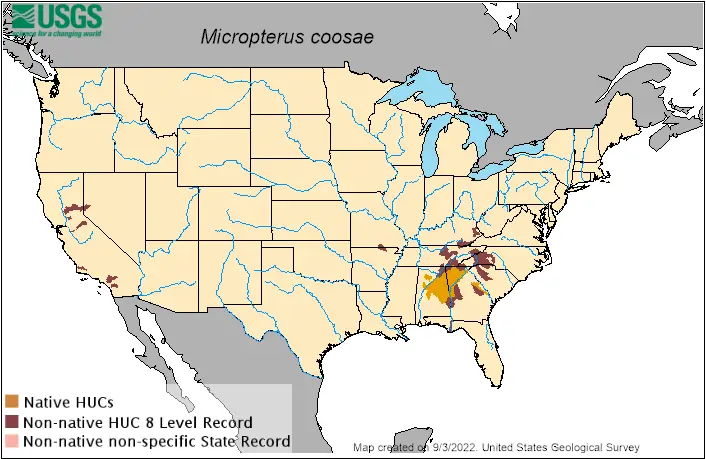
Some anglers and scientists also report finding this species in South Carolina in the northern part of the state. You might have luck locating them along the Savannah River basin as well as the Saluda, the Broad Rivers, and the Santee basin.
Occasionally, you can also find this fish in small portions of Tennessee.
Redeye Bass Typical Habitat
Most redeye prefer to live in clear, freshwater rivers and streams. They often travel through steep grades with fast-moving water, but they like to hang out in steady pools where they can relax and look for food.
Redeyes like to take shelter in rocky areas of water. Any spot with downed trees, logs, brush piles, and branches are ideal as they provide shelter and shade.
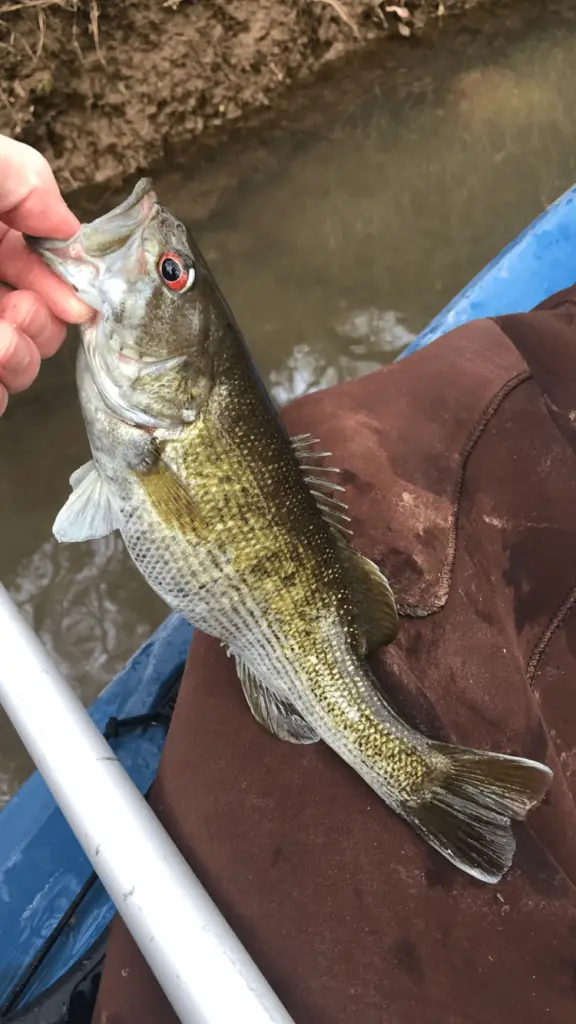
You’re not likely to find redeye in lakes, as the water gets too hot for them there. The merging currents of streams and rivers offer an ideal habitat, making it an excellent place to look for the bass.
Other places to cast your reel include docks, piers, inlets, outlets, cliffs, boulder pockets, sunken objects, and shoreline shallows.
How To Catch a Redeye Bass
Redeye bass can be exciting to catch because they put up such a good fight. Not only do they like to hide among various objects in the water, but they’re pretty scrappy with an aggressive, fighting spirit.

Despite the challenge this fish poses, there are several effective techniques for catching them. They include:
- Still Fishing
- Drift Fishing
- Bait Casting
- Trolling
It’s best to use a lightweight, 6-foot rod when reeling in redeye bass. A 4-pound monoline works best, as do large hooks to suit their large-sized mouths.
Start by observing your chosen location and approaching the spot from downstream. Redeye tend to look upstream, so approaching from this direction can prevent you from scaring them away.
Look for a close spot among rocks, sunken debris, branches, and other favorite coverings of this bass. Remember that the farther you cast, the more likely you are to spook multiple fish. Try to keep it close until you move to your next spot.
Using the Right Bait
Redeye bass are small fish, so their natural prey is even smaller. Their diet mainly includes terrestrial and aquatic insects, although they also feed on salamanders, crayfish, and sometimes smaller fish species.
Baits and lures similar to their prey tend to work best. With redeye, you can use both live and plastic bait. Minnows and small worms make for excellent live bait, while soft plastic lures like jigs, flies, and spoons are great lures.
Many freshwater fishing lures will work with redeye bass, as long as they are small enough to fit in its mouth. Surface lures also do a great job mimicking certain prey, like injured fish and surface insects.
Is Redeye Bass Safe To Eat?
Any kind of bass is safe to eat. What’s more, many bass species are pretty delicious when cooked up for dinner. The main concern about eating bass is the cleanliness of the water from which you caught them.
Water pollution can make it dangerous to eat a lot of bass, so research n the area where you’re fishing. Any overly murky water that contains a lot of algal blooms or takes on agriculture runoff likely has a ton of harmful and bad-tasting toxins.
You should also avoid eating bass displaying unusual markings like sores, spots, cysts, and other signs of illness. These could make you ill.
Age and size can also play a role in whether or not you should save and eat a redeye you catch. Younger fish have a milder, more palatable flavor and more delicate meat, making them the ideal choice.
Older fish have had longer to consume contaminants, which can increase their mercury count and sully their flavor.
For the sake of common sense and population protection, it’s best to toss back any bass that are right around the minimum size. For a redeye, that’s around 5 or 6 inches. You won’t get a lot of meat from these fish anyway, so it’s not worth saving.
It’s also worth it to mention that most people who fish for bass are doing so just for sport – meaning they catch and release them. Doing so is a personal preference, depending on where you’re fishing and whether you like the taste of bass or not.
Redeye Bass Reproduction
Redeye bass reproduce by spawning when the water is at the right temperature. Usually, that season starts in May and ends at the beginning of June. At this time, the water is typically between 62 and 68 degrees.
During the spawning season, the male fish will take charge by constructing their nests in any coarse gravel they can find. They will clear the area with their tail and dig a hole using their lower jaws.
Once the nests are ready, the young adult females will lay a whopping 2,000 to 3,000 eggs. Older females can lay as many as 11,000.
After a female chooses his nest and lays her eggs, the male will get to work fertilizing them. He then stays close by to guard and protect the eggs until they hatch.
Redeye bass can live up to 10 years.
Final Thoughts: Catching a Redeye Bass
The redeye bass is not an elusive fish, per se, but it can pose quite a challenge to anglers. Nonetheless, fishermen of all skill levels love to pursue this freshwater fish because it can be pretty fun to learn its habits and hunt them down.
Although most people catch and release redeye bass for sport, some choose to keep and eat the larger ones. They can make a delicious and nutritious meal if you know how to cook them properly.
If you’re interested in seeking out the redeye bass, be sure to study its identifying features. It’s easy to confuse this species with others in its genus, so knowing the details will prove crucial.
- Do You Need An Indicator For Nymph Fishing? - November 16, 2023
- Fishing Safety Tips For Families - September 25, 2023
- What Is The Best Time To Night Fish At A Lake? - September 18, 2023


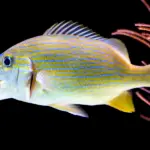
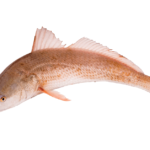
![How Much is a Montana Fishing License? [And When You Need One] montana fishing license](https://irvinelake.net/wp-content/uploads/2022/12/montana-fishing-license-1-150x150.jpg)


